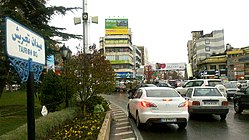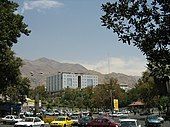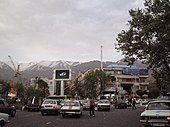Tajrish
Tajrish
تجريش | |
|---|---|
City in Tehran | |
 Tajrish Square | |
 Tajrish | |
| Coordinates: 35°48′16″N 51°25′32″E / 35.80444°N 51.42556°ECoordinates: 35°48′16″N 51°25′32″E / 35.80444°N 51.42556°E | |
| Country | |
| Province | Tehran |
| County | Shemiranat |
| Time zone | UTC+3:30 (IRST) |
| • Summer (DST) | UTC+4:30 (IRDT) |
Tajrish (Persian: تجريش, pronounced [tædʒˈɾiːʃ], also Romanized as Tajrīš)[1] is a neighbourhood of Tehran, capital of Iran. Administratively it is in Shemiranat County, Tehran Province. It used to be a village and later was absorbed into the city of Tehran.
The Tajrish neighbourhood is located along the northern edge of Tehran. This neighbourhood is one of the oldest parts of Tehran and during the last few decades, has become popular with the wealthy by virtue of the low levels of pollution, in turn created by the area's favorable location along Tehran's northern hills. Tajrish is situated in the Shemiranat County. As of 2006, the neighborhood had 86,000 inhabitants.
The Tajrish square itself is known as Sar-e Pol-e Tajrish (Persian: سر پل تجریش) which means At the Tajrish Bridge. This square is actually a vast bridge on top of a qanat river. In older times the locals used to call this bridge Gowgal, meaning "[The Bridge] of the Cow Herd.[2]
History[]
Until the 1920s, Tajrish and neighboring Shemiranat were a collection of small villages along Tehran's border, often used as a summer retreat by city residents. The area was relatively disconnected from Tehran's urban with the exception of Old Shemiran Road, currently known as Shariati Avenue. With the construction of Pahlavi Road (now named ) in 1930s and Modarres Highway, then known as Shahanshahi Boulevard, the Northern suburbs became highly accessible from downtown and rapid extension became possible.
Modern[]
Tajrish has an old bazaar and a mausoleum called Imam Zadeh Saleh, both popular tourist spots.
Tajrish Square is currently one of the busiest parts of Tehran, with bus terminals, cab terminals, and shopping malls including the popular . The square is where Valiasr Street terminates. Valiasr is the longest and, along with Shariati Avenue, one of the most important streets in Tehran. It is also one of the busiest transportation hubs in Tehran. Many other suburbs are accessible from this square. A major metro station, the northern terminus of line one (the red line) is located here.
Tajrish is the at the junction of streets that lead to Saad Abad Palace, Velenjak, Asad Abad, Zafaraniyeh, Elahieh, and Niavaran as well as many of the other places in northern Tehran.
Geography[]
Tajrish is located at the foot of the Alborz mountain range and Tajrish Square is located at an altitude of 1600 meters above sea level. Tajrish's climate is temperate and cold. The maximum temperature in summer is 36 degrees and the minimum in winter is -20 degrees. There have been several aqueducts in Tajrish and some of them are still flowing. Among them are Imam Zadeh Saleh aqueduct , Mohammadieh aqueduct, Maghsoudbak aqueduct along Darband river, Sarpol Tajrish aqueduct and Kahrizak aqueduct which was manifested in the lower support of Tajrish.
Population[]
The population of the city of Tajrish in 1335 was 26,525 and in the census of 1365 was about 40,000.In the 1996 census, due to Tajrish being connected to the city of Tehran and being located in the Greater Tehran area, its population was mentioned along with the population of Tehran.
Tajrish Bazaar[]
The traditional bazaar of Tajrish neighborhood will be renovated over 18 months at an estimated cost of about 28 billion rials.
The Deputy head of Tehran Beautification Organization for technical affairs, announced that the bazaar is close to as well as Velenjak, Darband and Darakeh mountain resorts and its renovation is a top priority for Tehran Beautification Organization. The official noted that the project will include reconstruction of the traditional market using both traditional and modern styles, wastewater collection, power, gas, telecommunication installations, as well as repair of small and large shops and passageways.
Tajrish bazaar has been built according to architectural style which closely resembles the traditional bazaar located in downtown Tehran. Some of its arches have been destroyed due to construction of multi-story buildings and its traditional identity has been threatened by irregularity of window shops and external view of new stores. “According to ratification by Tehran Municipality, the bazaar will be organized according to a new plan which will be implemented in cooperation with Tehran Cultural Heritage, Handicrafts and Tourism Organization. ” The official further stated that the project will take 18 solar months and the cost of organizing this economic and trade center in north Tehran has been estimated at about 28 billion rials.
Tajrish bazaar includes a roofed passageway through which thousands of people pass en route to paying pilgrimage to Emamzadeh Saleh or to the Bazaar for purchasing goods.
Older dialect[]
Tajrishi is a dialect of Persian which is nowadays almost extinct and replaced by standard Persian.
Iranian linguist Habib Borjian, after examining all the available material at hand concerning this dialect confirms it is a dialect of the Persian and writes: "Tajrishi shows no divergence from the Persid group, despite minor variation with respect to modern standard Persian. It is in verb morphology that we do find in Tajrishi a massive Caspian overlay, imposed on the dialect by means of age-old socio-economic ties with the districts to its north in the Alborz chain. We may thus characterize Tajrishi and other Shemirāni dialects as Persian with a significant Caspian imprint. Surprisingly enough, we find no trace of a Northwestern Iranian substratum in the dialect of Tajrish, nor do we find it in the scanty material available to us about the other extinct vernaculars of Shemirān ... This situation can only attest to an early Persianization of Rey and its adjoining settlements."[3]
The etymology of the word Tajrish itself is unknown.
Gallery[]

Tandiss Mall & Shopping Center, Tajrish

A view of Tajrish Square looking northward

Tajrish square in Spring

Tajrish Square in Winter

Valiasr Street before tajrish sq.

Tajrish sq in winter.

Tajrish district in winter.

Tajrish time square in winter.

Shahrdari street.

Ghaem shopping centre.

Inside Tajrish old markets.
References[]
- ^ Tajrish can be found at GEOnet Names Server, at this link, by opening the Advanced Search box, entering "-3086718" in the "Unique Feature Id" form, and clicking on "Search Database".
- ^ Journal of Persianate Studies 4 (2011) 246-271 brill.nl/jps The Extinct Dialect of Tajrish: Caspian or Persian? Habib Borjian Encyclopaedia Iranica. p.248.[1]
- ^ Journal of Persianate Studies 4 (2011) 246-271 brill.nl/jps T h e Extinct Dialect of Tajrish: Caspian or Persian? Habib Borjian Encyclopaedia Iranica. p.265.[2]
External links[]
| Wikimedia Commons has media related to Tajrish. |
- Neighbourhoods in Tehran
- Shemiranat County












